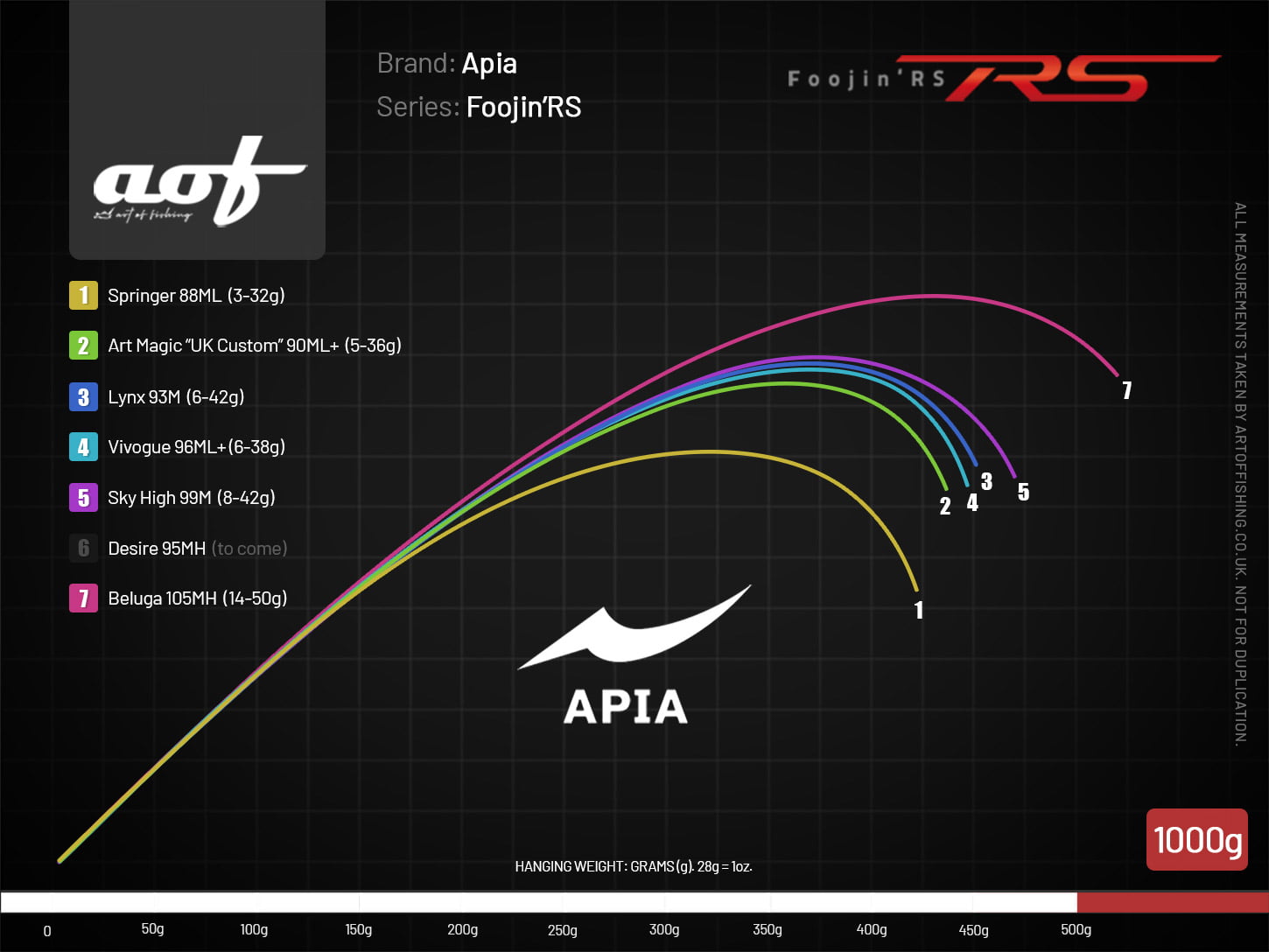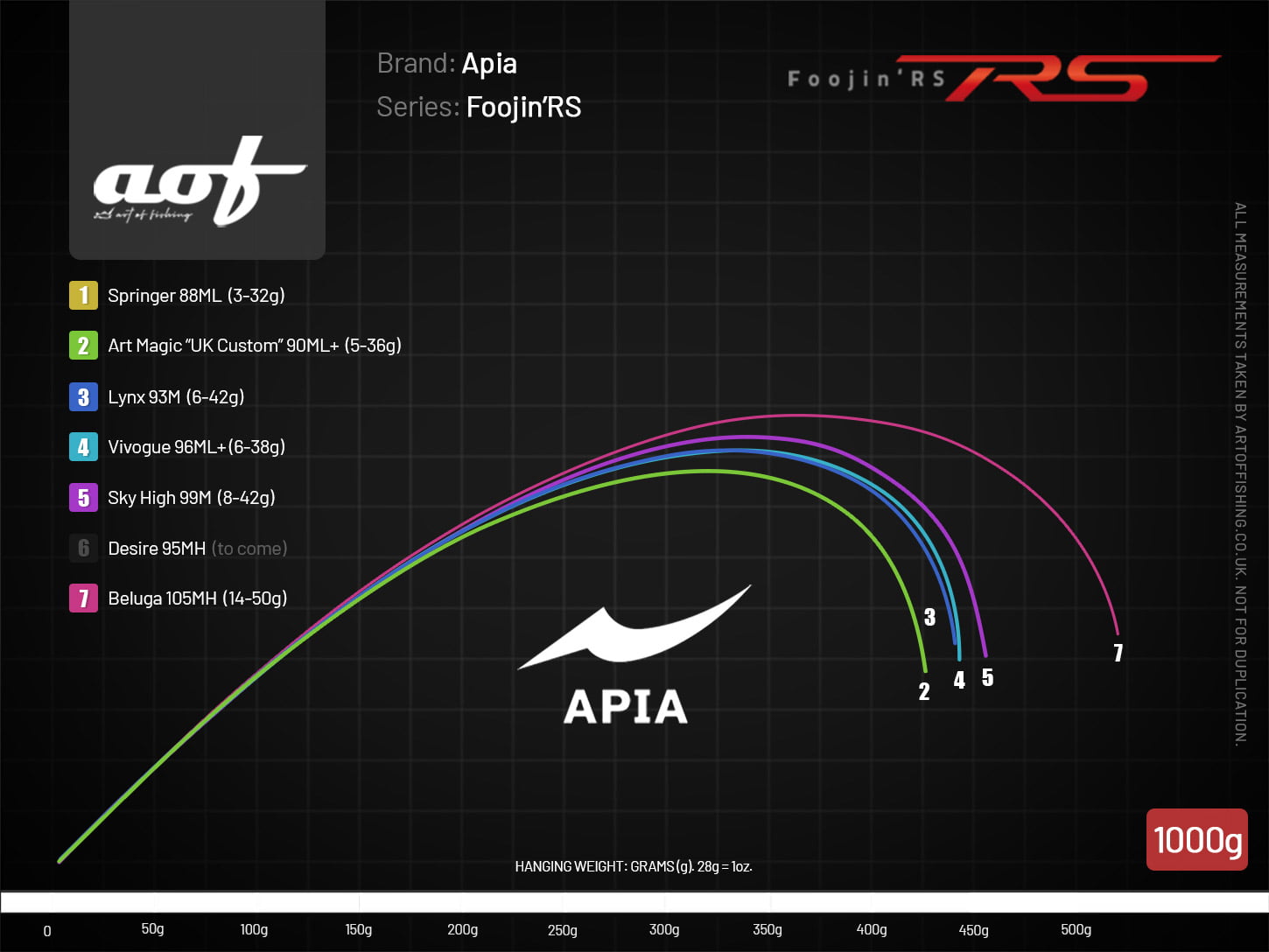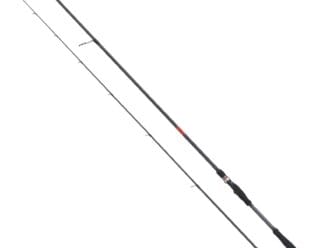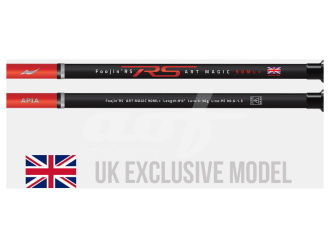Getting Bent 1: Apia Foojin’RS

Welcome to our new AOF blog series – “Getting Bent”.
Back in 2017, AOF launched what was – I think – the 4th incarnation of our website. It involved hundreds of hours of work, measuring, analysing and formatting all kinds of rod specs and charts. The reason for me doing it was to try and provide a more visual comparison for customers between one rod and the next. Buying rods online is hard, especially when you feel like you know what you’re after. So the fact that the casting weights and actions manufacturers put to rods aren’t always accurate is a shame. Sometimes I feel like they literally just make them up – so vastly different can two (apparently similar) rods be when you see them in the flesh.
Now in 2024, having made the decision to close our physical premises, I finally have the time to dedicate to this same level of detail. I enjoy numbers and analysing information. I’m the same with my fishing and I like to think about why I we do certain things and act outside of the box a bit. Just rather than catching fish however, my aim with this new series of blog posts is to try and give our customers a truer understanding of the differences between the rods we sell.
They say a picture paints a thousand words, and in the case of fishing rods, seeing one hooped over gives us at least a starting point from which to judge our impressions. It’s only part of the equation though as there are smaller elements to read in to that can help build the overall picture. It’s just a case of understanding what you’re looking at, and even understanding a little bit of science. It’s not that difficult though, so let me walk you through the first range of rods we’ve put to the test.

The Apia Foojin’RS series of rods has been one of our most popular ever. What Apia do and how they make their rods needs a post in its own right, but they are different – robust and powerful when they need to be, but easy to fish with light lures when you need to do that too.
The ‘RS range is second in line to the Foojin’Z and the two form the Apia “seabass” selection. Unlike some rod ranges, both the RS and Z contain numerous rods of completely different style. Both are complete ranges to cover nearly every eventuality – not simply one style of rod replicated in numerous lengths and casting weights. There’s a lot of work behind these.
As you will also see in future posts, after looking at the rods side by side we’ll then discuss them as individuals – how they differ to the others (or how they’re similar).
Section Navigation
How do we create these curves?
In our shop we have constructed an adjustable and stable base on which to attach each rod. Working on one rod at a time, a series of weights are then securely attached to the tip and photographs taken (from a fixed position) of the rod under various loads. I then plot these as accurately as I can with imaging software to create the charts. I can then plot these against each other or individually. As you’ll see below.
Within our bass rod category I have used a 500g weight as the default for comparison. This allows for all rods within the category to be compared side by side. Some rods will handle much more than 500g, while for others it’s the maximum I feel happy hanging on them (those only rated to 25g or so). The white lines on all of our charts are with a 500g weight on the end. For rods that will handle more, I have also included a 1kg line in grey. The latter shows much more information about the more powerful rods, but for comparison the 500g line still has to be the default.
In every chart I have also included a benchmark to compare against. The Tailwalk Hi-Tide SSD 90ML is one of our best sellers (£209.99) and one of the most capable, all-round, 35g rated 9’0” bass rods.
THE RESULTS
Rod bending curves plotted: 500g weight

Rod bending curves plotted:1kg weight

Now we can see some curves we get an immediate idea of how the power levels vary. On the whole, it’s actually what you’d expect just from looking at the casting weights of each respective model. In some cases it doesn’t tell the true story though!
What the curves do show you is how the actions differ. At 500g, rods with lighter tips are noticeable. You can see that the green and blue lines of the Art Magic (UK Custom), Vivogue and Lynx dip to a more severe degree. The Vivogue especially is noted for its light tip that then kicks in to its reserves of power around the 5th guide. You feel it when you’re fishing them, but the chart displays that feature. This particular rod is great for swimming soft plastic lures when you need a bit more length as it’s where that lighter tip really has its benefits.
Before I dive in to too much detail there though, let’s work through the rods; shortest to longest.

Foojin'RS Springer 88ML
The Springer is very obviously the lightest rod in the range. You’ll notice that we didn’t risk hanging 1kg from the end of this one. It’s an easy rod to bend and fish with, but – being an Apia – there are still true reserves of power in the butt.
It’s not the fastest action rod in the range, but it compares very nicely against the regular (and very versatile) action of the benchmark Tailwalk Hi-Tide SSD 90ML. The Springer has a lighter action, but is similar in the way it distributes the power.
It’s actually the lightness that makes it such an easy rod to cast. It will bend itself almost and doesn’t require a long handle. It’s far from floppy though. Anglers appreciating a more elastic, fun action will love this one.
-
Foojin’RS Springer 88ML
In stockRod Length: 8'8"£379.99
Casting - Max.: 32g
Casting - Min.: 3g
Sections: 2
Style: Spinning

Foojin’RS Art Magic UK Custom 90ML+
Our own AOF bass rod! Designed by me. These rods are available in the UK from July 2024.
To start with the tip… I’d guess on paper that I wanted our custom rod to be a little bit of a combination of others in the range. The Vivogue 96ML+ was always the most unique and an interesting starting point. Successfully combining a lighter tip with a powerful butt makes for an awesome rod. The “ML+” rating in the case of these is most easily described by considering a rod with a 30g tip and a 40g butt. I wanted a little bit of the same in the Custom. Indeed, the tip on the Custom is initially similar. However, where the power starts to kick in around about that 5th guide on the Vivogue, the Custom rod does it a bit more gradually. It creates a smoother curve of blended power.
For me, we’ve combined the tip and the power perfectly. I have every bit of lightness that I might want in the tip for fishing a soft plastic, but the power kicks in quickly and easy enough that twitching a surface lure is still easy too. Then at the base of the butt you’ve plenty of power for launching a 35g metal. In some ways the curve on this rod is pretty non-descript, but it’s a prime example of a high quality medium-light +PLUS bass rod. The “plus” is relevant due to the slight step of power we find in the butt over a typical “ML” rod – notable against the ML Tailwalk at 500g.
Some will initially pick up the Custom and feel a lot of stiffness, mostly due to the power in the butt and the beautiful push-in joint. However, the 1kg curve clearly shows how it easily bends when it’s under pressure.
Comparing at 500g to the benchmark Tailwalk rod, we see how the Art Magic has both a lighter tip and that more powerful butt. And at 1kg we can see how it is a lighter action rod than all but the Springer 88ML – which we did not plot at 1kg due to the lighter action. Sitting on its own in the Foojin’RS range, there is little to compare the end result to, which was the point of having it made! Despite starting with the Vivogue as a template, the end result (when we look at both 500g and 1kg curves) is perhaps a little bit more like a lighter version of the Lynx, but with a very slightly more cushioning tip too. It’s a much less stocky rod than the Lynx, but perhaps works in a similar-ish way with a bit less power.
-
Foojin’RS Art Magic 90ML+
In stockUK Custom
Rod Length: 9‘0"£399.99
Casting - Max.: 36g
Casting - Min.: 5g
Sections: 2
Style: Spinning

Foojin’RS Lynx 93M vs. Vivogue 96ML+
- Rod 1: Lynx 93M (rated 6-42g)
- Rod 2: Vivogue 96ML+ (rated 6-38g)
I think that the two rods to create a full study around would be the Lynx 93M and the Vivogue 96ML+ (next). The curves show them looking most similar of the lot, but I wouldn’t have expected that from fishing with them. Both feel faster action than most as we touched on before, but where they distribute their power differs.
Firstly, you notice the tips. It’s easy enough to see that the Vivogue has the slightly softer tip but with only 500g hanging on the end, past that it’s hard to tell whether they’re much different. At 1kg – with the rods being more compressed – it’s again difficult to see anything obvious. However, you’ll notice that around the middle and in to the butt section (these are two-piece rods) the Lynx has a little more power. You do have to look at the curves closely but you feel this in the flesh. The Lynx is what I always describe as “stocky”. In a way it’s a more evenly blended rod than the Vivogue, which is a little bit more specialist in design. The Lynx is still noticeably tippy, but that tip is slightly less elastic than the Vivogue meaning there’s less differentiation between the tip and the rest of the rod. The Vivogue doesn’t just jump immediately from “the tip” to “the rest” as it’s too clever a rod for that, but it is there.
Note that the Vivogue curve actually sits above the Lynx towards the bottom third/middle of the tip, despite it being the less powerful rod. This is partly down to the extra length the rod carries (I explain more in the Sky High analysis), but also suggests that the Vivogue – past that lighter tip – has a slightly slower taper or more progressive action than the Lynx. This is what helps the Vivogue to maintain fast recovery and direct lure control even with its lighter tip. It also puts more strain on the rest of the rod below, which is why the Vivogue butt then dips more than the Lynx. If the base/middle of the tip section had been more in line with the light tip, a rod of this length may have been difficult to control as the whole thing would have felt too soft at 9’6” long.
Ultimately, all rods that we plot curves for can be defined – power wise – but what’s happening in the butt. The less curvature, technically the more power they have. The curve on the tip will demonstrate how capable they are at fishing certain lure types but does not define what weight they will cast. Saying that, I would not trust all manufacturers to create a rod that is both light in the tip and powerful in the butt without the rod becoming prone to breakages. During the cast this would theoretically compress the tip too quickly and put all of the strain on the butt section or base of the tip. However, Apia rods are solid and I trust them implicitly. Not many could do what they do.
Speaking of what they can do, check out a report that Henry Gilbey post on his blog earlier this year about a Portuguese bass caught on the Lynx. If landing an 18lber in rough conditions doesn’t show you how capable these rods are, nothing will.
-
Foojin’RS Lynx 93M
Ordered upon requestRod Length: 9'3"£389.99
Casting - Max.: 42g
Casting - Min.: 6g
Sections: 2
Style: Spinning -
Foojin’RS Vivogue 96ML+
In stockRod Length: 9'6"£389.99
Casting - Max.: 38g
Casting - Min.: 6g
Sections: 2
Style: Spinning

Foojin’RS Sky High 99M
I’ve made no secret in the shop that (until the Custom came along) the Sky High was my favourite in the range for our fishing on the north coast of Cornwall. I’ve never cast another rod that fires lures as far as this one. I’ve measured them!
The curves…. This is where things get a bit misleading…
You would be forgiven for thinking that the Sky High has more power than the likes of the Lynx 93M. Even though they have the same 42g maximum casting weight.
What’s actually evident here is that rod length can skew our immediate impressions on any chart of curves like these.
With the jump in length of 6” over the Lynx (9’9” vs. 9’3”), the curve is projected both further and higher in to the chart. Take off that 6” at the butt and the curves of the two rods would be more alike. If anything, the Sky High would start bending slightly lower in to the butt section. In fact, it wouldn’t have a 42g rating at all without that bottom 6”. Perhaps more like 40g as it’s the lower parts of the butt that will decide the stated casting weight. Take off the back 6” of any tapered rod and your new butt diameter is less – meaning the max. casting weight would be reduced. This is what you feel when casting the Sky High. It’s a slightly more forgiving rod than the Lynx. Despite this, the curves make it look more powerful. It’s something to me mindful of on charts like these. It’s relevant too with the Vivogue and Lynx comparisons we did just now. Take 3” off of the Vivogue and I think that curve would have tucked back in just under that of the Lynx.
-
Foojin’RS Sky High 99M
Ordered upon requestRod Length: 9'9"£399.99
Casting - Max.: 42g
Casting - Min.: 8g
Sections: 2
Style: Spinning

Foojin’RS Desire 95MH
Sadly they’re out of stock of these at the moment but we’ll have more arriving soon to test. I fully expect the curves to fill the gap between the Sky High 99M and the Beluga 105MH.
-
Foojin’RS Desire 95MH
Ordered upon requestRod Length: 9'5"£399.99
Casting - Max.: 50g
Casting - Min.: 12g
Sections: 2
Style: Spinning

Foojin’RS Beluga 105MH
Designed as a casting rod, you can see how the curve of the Beluga is a bit more progressive. Josh and I were both impressed by how easily it bent, given the perceived power. A little like my explanation above, being a much longer rod than the others with a higher rating doesn’t mean it’s a complete animal. That extra 12” in length is again, all in the butt. So the tip and middle are still far from brutish. It’s an easy rod to cast and bend. But does have stacks of power lower down. Even taking 12” off the rod and reimagining it on the chart, it would still propel higher than the others thanks to the 50g rating, but it’s not a poker. I’m not sure if we ever really reviewed the Beluga fully, but if I ever needed a rod for big seas and super rough conditions, the Beluga would be a very safe bet. Anglers travelling to the likes of Portugal would really appreciate these I think. That said, Henry and I were both impressed with the fact it would still fish a weedless Gravity Stick. That’s down to the top third not being too stiff.
-
Foojin’RS Desire 95MH
Ordered upon requestRod Length: 9'5"£399.99
Casting - Max.: 50g
Casting - Min.: 12g
Sections: 2
Style: Spinning
The Getting Bent Summary
I know it’s taken a bit of reading and thinking about, but I hope you’ve enjoyed the first in our Getting Bent series. Not all future posts will be as long as this one as there are a few points made here that won’t be worth repeating on every chart. I might actually split a few things off in future to create a reference point for little technical reasonings and descriptions.
The full Foojin’RS range is available through our website on the link below. The Art Magic “UK Custom” rods are available for pre-order now as numbers will be limited.


